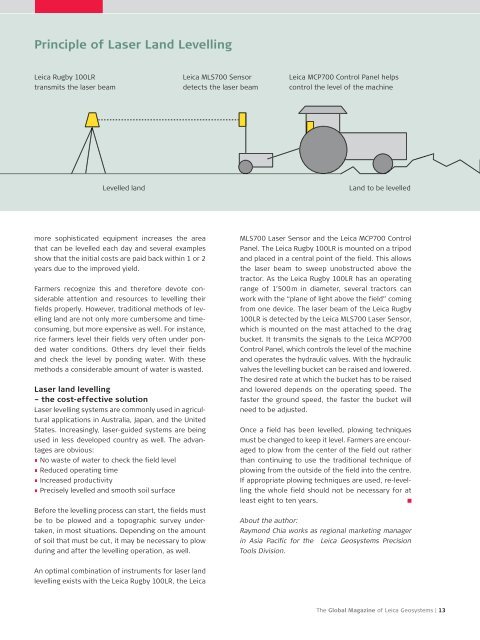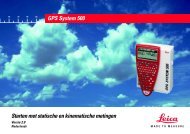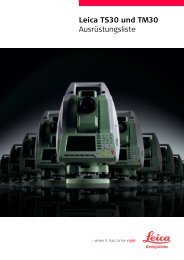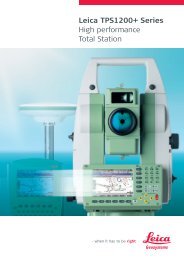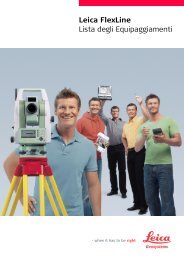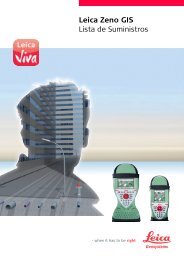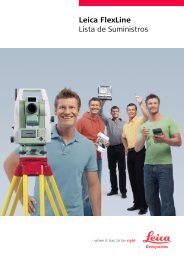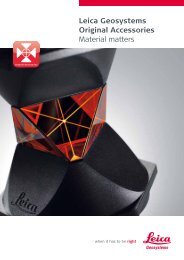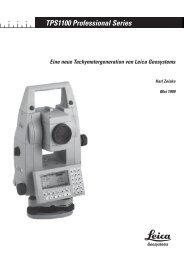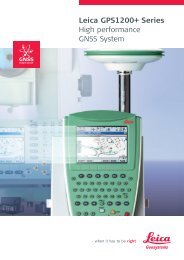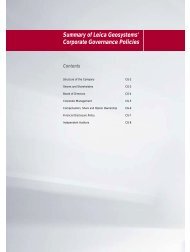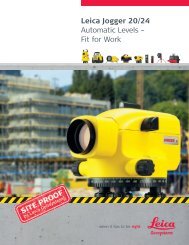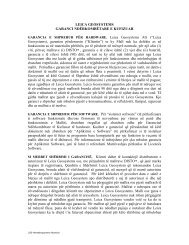The Global Magazine of Leica Geosystems
The Global Magazine of Leica Geosystems
The Global Magazine of Leica Geosystems
Create successful ePaper yourself
Turn your PDF publications into a flip-book with our unique Google optimized e-Paper software.
Principle <strong>of</strong> Laser Land Levelling<br />
<strong>Leica</strong> Rugby 100LR<br />
transmits the laser beam<br />
more sophisticated equipment increases the area<br />
that can be levelled each day and several examples<br />
show that the initial costs are paid back within 1 or 2<br />
years due to the improved yield.<br />
Farmers recognize this and therefore devote considerable<br />
attention and resources to levelling their<br />
fields properly. However, traditional methods <strong>of</strong> levelling<br />
land are not only more cumbersome and timeconsuming,<br />
but more expensive as well. For instance,<br />
rice farmers level their fields very <strong>of</strong>ten under ponded<br />
water conditions. Others dry level their fields<br />
and check the level by ponding water. With these<br />
methods a considerable amount <strong>of</strong> water is wasted.<br />
Laser land levelling<br />
– the cost-effective solution<br />
Laser levelling systems are commonly used in agricultural<br />
applications in Australia, Japan, and the United<br />
States. Increasingly, laser-guided systems are being<br />
used in less developed country as well. <strong>The</strong> advantages<br />
are obvious:<br />
No waste <strong>of</strong> water to check the field level<br />
Reduced operating time<br />
Increased productivity<br />
Precisely levelled and smooth soil surface<br />
Before the levelling process can start, the fields must<br />
be to be plowed and a topographic survey undertaken,<br />
in most situations. Depending on the amount<br />
<strong>of</strong> soil that must be cut, it may be necessary to plow<br />
during and after the levelling operation, as well.<br />
An optimal combination <strong>of</strong> instruments for laser land<br />
levelling exists with the <strong>Leica</strong> Rugby 100LR, the <strong>Leica</strong><br />
<strong>Leica</strong> MLS700 Sensor<br />
detects the laser beam<br />
<strong>Leica</strong> MCP700 Control Panel helps<br />
control the level <strong>of</strong> the machine<br />
Levelled land Land to be levelled<br />
MLS700 Laser Sensor and the <strong>Leica</strong> MCP700 Control<br />
Panel. <strong>The</strong> <strong>Leica</strong> Rugby 100LR is mounted on a tripod<br />
and placed in a central point <strong>of</strong> the field. This allows<br />
the laser beam to sweep unobstructed above the<br />
tractor. As the <strong>Leica</strong> Rugby 100LR has an operating<br />
range <strong>of</strong> 1’500 m in diameter, several tractors can<br />
work with the “plane <strong>of</strong> light above the field” coming<br />
from one device. <strong>The</strong> laser beam <strong>of</strong> the <strong>Leica</strong> Rugby<br />
100LR is detected by the <strong>Leica</strong> MLS700 Laser Sensor,<br />
which is mounted on the mast attached to the drag<br />
bucket. It transmits the signals to the <strong>Leica</strong> MCP700<br />
Control Panel, which controls the level <strong>of</strong> the machine<br />
and operates the hydraulic valves. With the hydraulic<br />
valves the levelling bucket can be raised and lowered.<br />
<strong>The</strong> desired rate at which the bucket has to be raised<br />
and lowered depends on the operating speed. <strong>The</strong><br />
faster the ground speed, the faster the bucket will<br />
need to be adjusted.<br />
Once a field has been levelled, plowing techniques<br />
must be changed to keep it level. Farmers are encouraged<br />
to plow from the center <strong>of</strong> the field out rather<br />
than continuing to use the traditional technique <strong>of</strong><br />
plowing from the outside <strong>of</strong> the field into the centre.<br />
If appropriate plowing techniques are used, re-levelling<br />
the whole field should not be necessary for at<br />
least eight to ten years.<br />
About the author:<br />
Raymond Chia works as regional marketing manager<br />
in Asia Pacific for the <strong>Leica</strong> <strong>Geosystems</strong> Precision<br />
Tools Division.<br />
<strong>The</strong> <strong>Global</strong> <strong>Magazine</strong> <strong>of</strong> <strong>Leica</strong> <strong>Geosystems</strong> | 13


